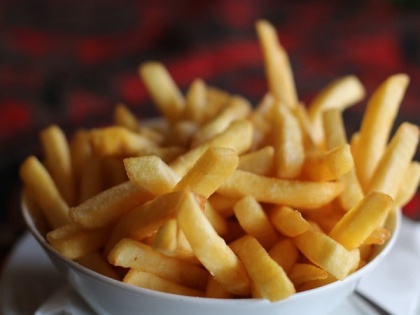Eating starchy snacks associated with higher risk of cardiovascular disease: Study
By ANI | Published: June 23, 2021 05:15 PM2021-06-23T17:15:18+5:302021-06-23T17:25:07+5:30
Can starchy snacks harm heart health? A new study suggests that they might!

Eating starchy snacks associated with higher risk of cardiovascular disease: Study
Can starchy snacks harm heart health? A new study suggests that they might!
The new study found that eating starchy snacks high in white potato or other starches after any meal was associated with at least a 50 per cent increased risk of mortality and a 44-57 per cent increased risk of CVD-related death.
Conversely, eating fruits, vegetables, or dairy at specific meals is associated with a reduced risk of death from cardiovascular disease, cancer, or any cause.
The findings of the study were published in the Journal of the American Heart Association.
"People are increasingly concerned about what they eat as well as when they eat," said Ying Li, Ph.D., lead study author and professor in the department of nutrition and food hygiene at Harbin Medical University School of Public Health in Harbin, China.
"Our team sought to better understand the effects different foods have when consumed at certain meals," added Li.
Li and colleagues analysed the results of 21,503 participants in the National Health and Nutrition Examination Survey (NHANES) from 2003 to 2014 in the US to assess dietary patterns across all meals.
Among the study population, 51 per cent of participants were women and all participants were ages 30 or older at the start of the study. To determine patient outcomes, researchers used the US Centers for Disease Control and Prevention's National Death Index to note participants who died through December 31, 2015, due to CVD, cancer, or any cause.
Researchers categorised participants' dietary patterns by analyzing what types of food they ate at different meals. For the main meals, three main dietary patterns were identified for the morning meal: Western breakfast, starchy breakfast and fruit breakfast.
Western lunch, vegetable lunch and fruit lunch were identified as the main dietary patterns for the mid-day meal. Western dinner, vegetable dinner and fruit dinner were identified as the main dietary patterns for the evening meal.
For snacks, grain snacks, starchy snacks, fruit snacks and dairy snacks were identified as the main snack patterns in between meals. Additionally, participants who did not fit into specific meal patterns were analyzed as a reference group. The researchers noted that the Western dietary pattern has higher proportions of fat and protein, which is similar to many North American meals.
Participants in the Western lunch group consumed the most servings of refined grain, solid fats, cheese, added sugars, and cured meat. Participants in the fruit-based lunch group consumed the most servings of whole grain, fruits, yogurt and nuts.
Participants in the vegetable-based dinner group consumed the most servings of dark vegetables, red and orange vegetables, tomatoes, other vegetables and legumes. Participants who consumed starchy snacks consumed the most servings of white potatoes.
1. Eating a Western lunch (typically containing refined grains, cheese, cured meat) was associated with a 44 per cent increased risk of CVD death.
2. Eating a fruit-based lunch was associated with a 34 per cent reduced risk of CVD death.
3. Eating a vegetable-based dinner was associated with a 23 per cent and 31 per cent reduction in CVD and all-cause mortality, respectively.
4. Consuming a snack high in starch after any meal was associated with a 50-52 per cent increased risk of all-cause mortality and a 44-57 per cent increased risk in CVD-related mortality.
"Our results revealed that the amount and the intake time of various types of foods are equally critical for maintaining optimal health," said Li.
Li added, "Future nutrition guidelines and interventional strategies could integrate optimal consumption times for foods across the day."
Limitations to this study include that dietary data was self-reported by participants, which may lead to recall bias. And, although the researchers controlled for potential confounders, other unmeasured confounding factors cannot be ruled out.
( With inputs from ANI )
Disclaimer: This post has been auto-published from an agency feed without any modifications to the text and has not been reviewed by an editor
Open in app